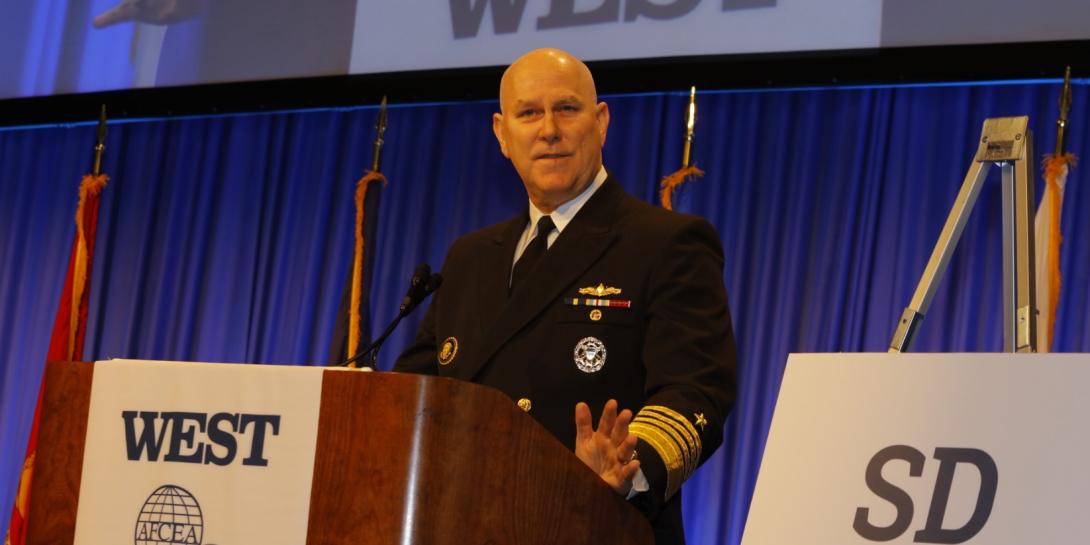Navy Revolutionizing Readiness
The U.S. Navy is in the nascent stages of a plan to revolutionize readiness through the use of artificial intelligence, machine learning and data analytics. It also may include the establishment of two new offices: a chief readiness office and an analytics office.
Adm. Christopher Grady, USN, U.S. Fleet Forces commander, announced the plan at the AFCEA-USNI West 2019 Conference in San Diego. The admiral said that one of his most important “strategic lines of effort” is to revolutionize the approach to readiness. “To win great power competition and to maintain our competitive advantage, particularly given our customary fiscal constraints and restraints, we need to bend the curve on readiness, and we need to proceed with some urgency,” he said. “This is because while we build the Navy the nation needs, we must be able to fight with the Navy the nation has. Remember, 70 percent of the Navy we have today we will fight with in 2030.”
Adm. Grady said that as fleet commander, he is in the “readiness business,” and is not happy about the lack of an analytically based, integrated readiness assessment capability. “I believe that hampers our agility. We need to squeeze more readiness out of every dollar we get,” he added. “We currently experience too much friction in both the force generation and resource allocation process supporting readiness.”
The revolution will require some fundamental changes in the service’s approach to readiness—how officials generate it, analyze it, measure it and integrate it, and how they articulate what they need and predict what the return on the readiness investment might be, the admiral explained.
As the officials progress on what he termed the Revolutionize Readiness Campaign plan, they will look for readiness improvements across three focus areas: operational readiness, readiness sustainability and enabling industrial base performance. Regarding the first, the admiral said, “The goal here is to maximize the effectiveness of today’s fleet, being able to fight and win with the Navy the nation has.”
On sustainability, he said service officials want to “assess how we are structured in order to create readiness sustainability and also assess agility.” And regarding the industrial base, a few examples, including an effort to “improve predictability through the whole ship depot maintenance process by building a more comprehensive understanding of the maintenance of our ships.”
The campaign plan will include an attempt to “derive a hierarchy of readiness metrics from the fleet level to the unit level, first reviewing what we are being asked to do from the operational level of war down to the tactical level,” essentially meaning the service will have “metrics associated with every item on the mission essential task list.”
The plan may include the creation of a new office focused on readiness. “I’m actually considering whether to establish a chief readiness officer that will fit within the panoply of force development, force generation and force employment. We’ll call it force readiness,” Adm. Grady revealed, adding that the office will “more cohesively integrate, align and assess” fleet readiness.
Adm. Christopher Grady, CDR, U.S. Fleet Forces: . I look at readiness as a domain. #WEST2019 #AFCEA
— George Seffers (@gseffers) February 15, 2019
“As part of this, we will examine the readiness reporting relationships of the various enterprises—aviation, undersea warfare, surface warfare, expeditionary warfare, information warfare and the shore enterprise,” he reported.
A related effort calls for the digitization of readiness. “When we in the Navy, or the rest of the military for that matter, talk about digitization, talk about analytics, machine learning, artificial intelligence, we usually see this through the fleet lens. We talk about how to achieve decision superiority in the fleet fight. That’s all good,” he said. “But fleet readiness will benefit significantly by bringing all of the same tools to bear on all of our readiness processes. In fact, I would argue that we have more unused data available for us here than we currently do in the fight.”
Data analytics tools will help the service maintain the competitive advantage by developing a deeper understanding of the link between actions and readiness outcomes. “We will use descriptive analytics to mine historic data and to derive the readiness drivers behind past successes or failures. I believe this will move our understanding of readiness beyond a set of closely held beliefs and to vigorously derived facts," the commander elaborated. “Once we understand the true drivers behind our readiness outcomes, we must apply predictive analytics to forecast how much outcomes will change with our investments in those readiness drivers. With predictive analytics in play, we will find ourselves in a place where we’re making data-informed decisions, maximizing the return on investment for taxpayers.”
Once the service gets the predictive analytics capability, prescriptive analytics will be the next step. “If I really achieve this, get my way here, the final frontier of analytical capabilities will take us to prescriptive analytics where our automated analytical tools will accelerate our decision making by suggesting decision options we may not have been aware of if we relied on human action alone,” the admiral suggested.
To get there, he is considering another new office, the fleet analytics office, which will “develop the dashboards and reporting tools to see in real time what is going on. They will also develop a risk matrix that helps us assess risk against the mission and drive accountability,” he said.
But the service also needs to determine something else. “We also need to assess whether we have the modern IT structure in place to support these efforts across the Navy’s readiness exercise,” Adm. Grady stated.





Comments